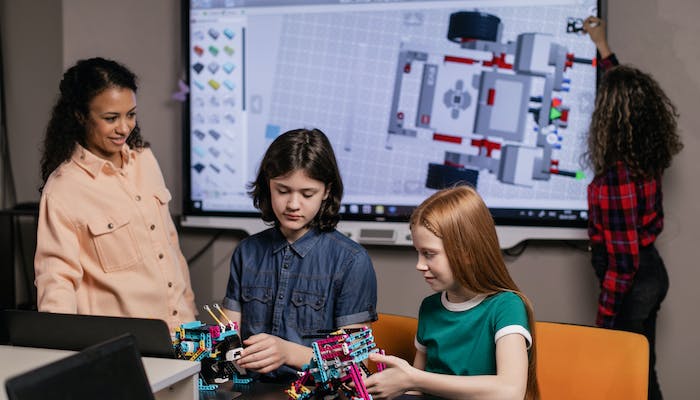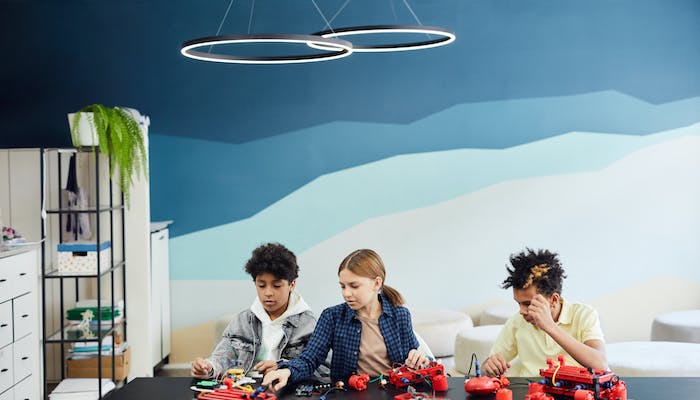Role of Teacher in Developing Creativity among Students
The role of a teacher in developing creativity among students is undeniably significant, shaping the intellectual landscape and future success of learners. Research consistently underscores the positive impact of educators who actively foster creative thinking. According to a study by Kyung Hee Kim, a professor at the College of William & Mary, creativity scores among students in the United States have seen a steady decline since the 1990s. This highlights the urgency for teachers to actively engage in strategies that enhance creative capacities. Through deliberate efforts to create an environment conducive to original thinking, educators become architects of innovation, guiding students toward solutions that transcend conventional boundaries. For instance, teachers can encourage project-based learning, where students collaborate on real-world challenges, providing them with the opportunity to apply creative problem-solving skills. The teacher’s role as a facilitator and motivator is paramount, as they inspire a passion for learning and curiosity that extends beyond textbooks, nurturing a generation equipped to navigate the complexities of an ever-evolving world.

Why Creativity among Students is Important?
Students need to be creative because creativity is a catalyst for intellectual growth, personal development, and success in an ever-changing world. Beyond the confines of traditional academic achievement, creativity equips students with the ability to think critically, solve complex problems, and adapt to dynamic challenges. It is the cornerstone of innovation and progress, driving advancements in science, technology, the arts, and various fields. Creative individuals are more likely to excel in collaborative environments, fostering effective teamwork and communication skills. Moreover, creativity serves as a powerful tool for self-expression, allowing students to explore and articulate their thoughts, emotions, and identities. By nurturing creativity, educators empower students to approach learning with enthusiasm, curiosity, and a lifelong commitment to evolving their skills. Ultimately, a creative mindset is an indispensable asset that not only enriches academic pursuits but also prepares students for the multifaceted demands of a globalized and interconnected society.
Example:
Consider a high school teacher who integrates project-based learning into the science curriculum. Instead of traditional lectures, students are tasked with designing and conducting their own scientific experiments. This approach not only requires a deep understanding of scientific principles but also encourages creative thinking as students devise innovative ways to test hypotheses. The teacher’s role extends beyond imparting facts; they guide students through the process, offering constructive feedback, fostering collaboration, and celebrating the diverse approaches students take. This example illustrates how a teacher, through intentional strategies, can cultivate creativity by providing an environment that goes beyond rote learning, allowing students to actively engage in the scientific method with curiosity, imagination, and critical thinking.
Teachers play a crucial role in the development of creativity in students. Here are some key aspects of their role:
1. Creating a Positive Learning Environment:
Teacher’s role in the development of creativity among students is intrinsically linked to the cultivation of a positive learning environment. Establishing an atmosphere conducive to learning is pivotal for unlocking and nurturing creative potential. Teachers are not only purveyors of knowledge but also architects of an environment where curiosity, collaboration, and expression flourish. By fostering open communication, educators create a space where students feel empowered to articulate their thoughts and ideas without fear of criticism. Moreover, promoting mutual respect and inclusivity ensures that the classroom becomes a melting pot of diverse perspectives, enhancing the creative discourse.
Teachers strategically employ collaborative learning methods, recognizing that shared exploration of ideas not only builds a sense of community but also exposes students to varied viewpoints, enriching their creative thinking. Embracing a positive perspective on mistakes as valuable learning opportunities is paramount, fostering resilience and a willingness to take risks in the pursuit of innovation. Ultimately, the deliberate efforts of teachers in creating a positive learning environment serve as the bedrock for unleashing the creative spirit within each student, preparing them for a future that demands ingenuity and adaptability.
2. Encouraging Critical Thinking:
In the educational landscape, the role of a teacher in fostering creativity among students is intricately linked to the encouragement of critical thinking. Teachers serve as guides, steering students beyond rote memorization toward a realm where analytical skills are honed and creativity is sparked. Through thought-provoking questions and challenges, educators prompt students to delve deeper into subjects, fostering a habit of questioning, analyzing, and synthesizing information. This cultivation of critical thinking is not just a means of academic enrichment but a vital component in the development of a creative mindset. By nurturing the ability to dissect problems, evaluate various perspectives, and construct well-reasoned arguments, teachers empower students to approach challenges with innovative solutions, laying the groundwork for a future where creativity and critical thinking converge seamlessly.
3. Open-Ended Assignments:
Strategic incorporation of open-ended assignments plays a pivotal role in the teacher’s efforts to cultivate creativity among students. These assignments, by their very nature, eschew the confines of predefined answers and encourage students to explore divergent paths of thinking. Teachers, acting as facilitators, provide students with the autonomy to shape their responses, fostering a sense of ownership over their learning journey. Open-ended assignments not only stimulate creativity but also nurture problem-solving skills, resilience, and the ability to approach challenges with innovative perspectives. The educational landscape is thus enriched as students engage in tasks that go beyond rote memorization, promoting a deeper understanding of content and fostering a mindset that values exploration, experimentation, and the creative process.
4. Encourage collaboration:
In the educational context, the teacher assumes a pivotal role in fostering creativity by actively encouraging collaboration among students. By designating collaborative projects, group activities, or interactive discussions, educators create a learning environment where students can synergize their diverse perspectives and insights. Collaboration not only enhances social and interpersonal skills but also serves as a catalyst for creative thinking.
Through cooperative efforts, students learn to appreciate the value of collective intelligence, where the sum of individual contributions results in a more comprehensive and innovative outcome. Teachers, in this role, facilitate the exchange of ideas, encouraging students to draw inspiration from their peers and fostering a collaborative mindset that extends beyond the classroom. This collaborative approach not only enriches the learning experience but also prepares students for a future that increasingly demands teamwork, adaptability, and the ability to navigate complex challenges collectively.

5. Integrating Arts and Creativity:
The role of a teacher in fostering creativity is exemplified through the deliberate integration of arts and creative practices into the curriculum. Teachers act as architects, intentionally infusing various forms of artistic expression to enrich the learning experience. By incorporating visual arts, music, drama, and other creative mediums, educators provide students with avenues to explore, experiment, and communicate beyond traditional academic boundaries. This integration not only nurtures a holistic approach to learning but also fosters a deeper understanding of diverse subjects. Moreover, the arts stimulate imaginative thinking, allowing students to perceive and interpret information in unique ways. Through this intentional blending of arts and academia, teachers contribute significantly to the development of creativity among students, preparing them for a future where innovation and originality are highly valued.
6. Providing Constructive Feedback:
In the realm of education, the teacher’s role in cultivating creativity among students is exemplified through the art of providing constructive feedback. Teachers serve as insightful guides, offering nuanced evaluations that transcend mere assessment and delve into the intricate layers of the creative process. Constructive feedback, delivered with a pedagogical finesse, focuses not only on the final outcome but also on the journey of ideation and refinement. It acts as a beacon, guiding students through the maze of creative exploration, emphasizing the value of persistence, innovation, and the invaluable lessons embedded within setbacks. By fostering an environment where feedback is constructive and growth-oriented, teachers instill in students a resilience that is vital for navigating the complexities of creative endeavors. This pedagogical approach not only sharpens creative acumen but also shapes a mindset wherein challenges are embraced as catalysts for continuous improvement, propelling students toward a future where creativity reigns supreme.
7. Experiment new Activities:
Educators act as catalysts for innovation, introducing fresh and engaging learning experiences that go beyond conventional methodologies. By incorporating novel activities into the curriculum, teachers inspire curiosity and stimulate imaginative thinking. These activities serve as vehicles for students to explore uncharted territories, encouraging them to step outside their comfort zones and embrace the unknown. Through experimentation, teachers not only ignite a sense of excitement in the learning process but also cultivate a culture where creative problem-solving and adaptability are nurtured. This pedagogical approach reflects a commitment to providing students with diverse opportunities to develop their creative capacities, preparing them for a future that values versatility and original thinking.
8. Talk with Colleagues:
Collaborative exchange between teachers holds significant potential in fostering creativity among students. Engaging in thoughtful discussions and sharing insights with colleagues becomes a vital component of the teacher’s role in nurturing creativity. These conversations serve as a platform for the exchange of innovative teaching strategies, successful practices, and challenges faced in the quest to stimulate creativity within the classroom. Collaborative discourse allows educators to draw from a collective pool of experiences, gaining diverse perspectives that enrich their instructional approaches. By fostering a culture of open communication and collaboration, teachers not only enhance their own professional development but also contribute to the collective advancement of creativity-promoting strategies. This collegial synergy becomes a dynamic force in shaping an educational environment that nurtures the creative spirit of students, preparing them for a future that demands ingenuity and adaptability.
The role of a teacher in fostering creativity involves creating an environment that supports curiosity, providing opportunities for expression, and guiding students to develop a growth mindset. By embracing these elements, educators contribute significantly to the holistic development of students as creative and innovative thinkers.
In conclusion, the pivotal role of a teacher in the development of creativity among students cannot be overstated. Educators are not merely conveyors of information; they are architects of an environment that stimulates imagination, fosters critical thinking, and encourages innovative problem-solving. Through a myriad of strategies, from integrating arts into the curriculum to providing constructive feedback and promoting collaborative learning, teachers shape the mindset of future generations.
Their influence extends far beyond the confines of academic success, as they cultivate a spirit of curiosity, resilience, and adaptability crucial for navigating an ever-evolving world. In recognizing and celebrating the transformative impact of teachers on the creative development of students, we acknowledge the profound significance of their role in shaping not just educational outcomes, but the very fabric of a society that values and thrives on innovation.

